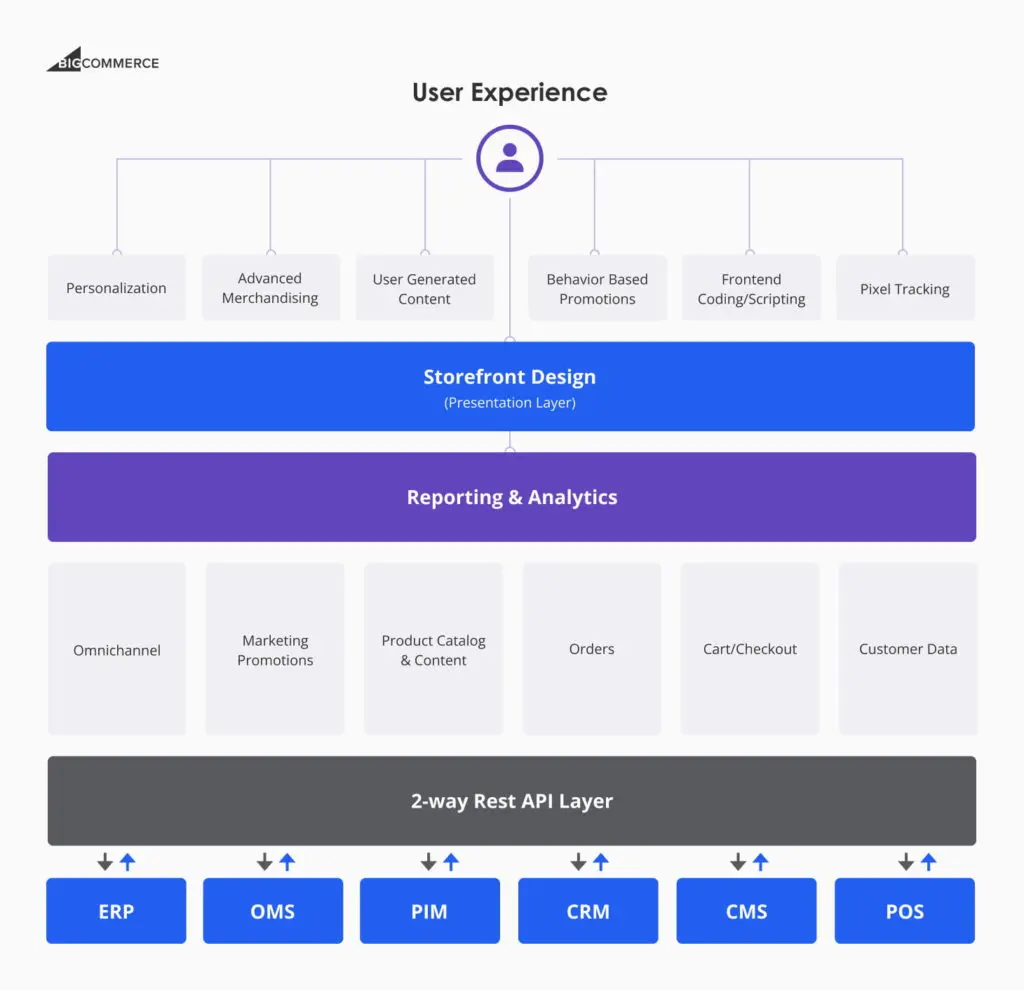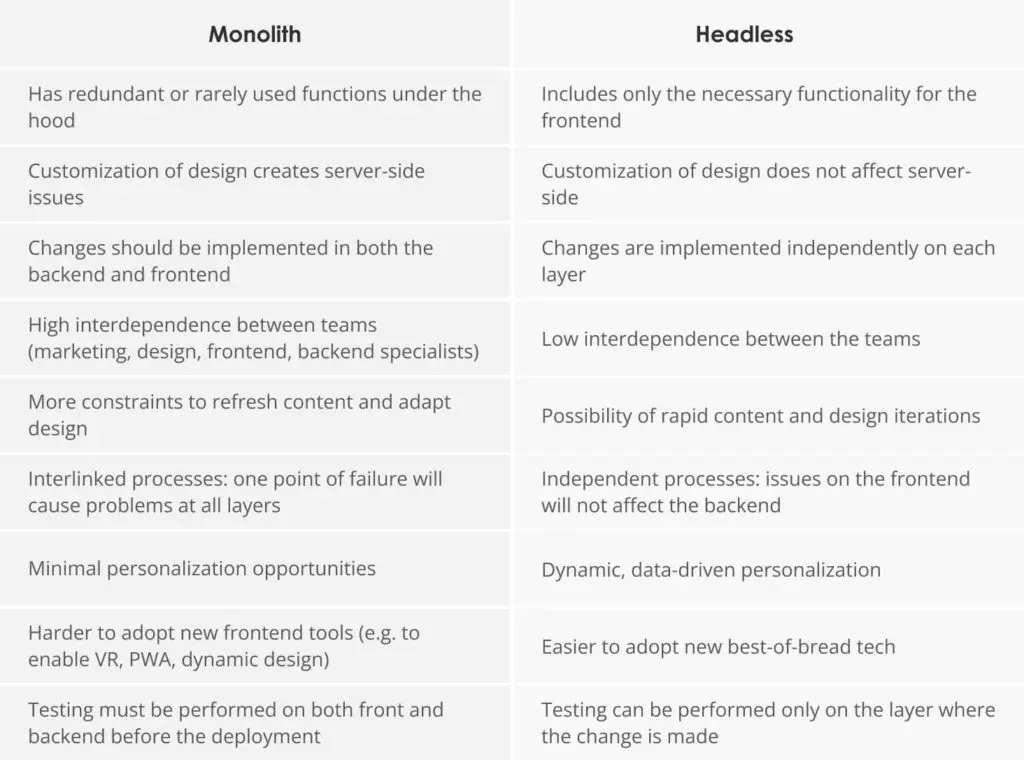A game-changer is right beneath our noses. Retailers can increase revenue, remove the friction between marketing and IT teams, and improve customer experience with headless commerce architecture.
Headless commerce is on everyone’s lips in the world of retail. According to State of the Headless CMS Market 2022, awareness about headless architecture has significantly increased amongst merchants in the last three years. In 2020, just above 40% of merchants were familiar with this term. In 2022, 65% knew what headless commerce is.
But what makes headless ecommerce such a promising technology vector? Let’s dig in!
What is Headless Commerce?
Headless commerce is a technological architecture layout where the user-facing store components are separate from the backend and transactional functionality.
The headless architecture allows companies to use several frontend layers for their ecommerce website. The API-first nature of headless architecture will enable merchants to select best-of-breed technologies for building their stores. Using custom frontends, you rapidly bring new campaigns to multiple sales channels — mobile, web, smart devices, or self-service kiosks — without worrying about server-side code.
Headless stands for the H in MACH — a set of technology principles that underpin best-in-class technology platforms.
Why Do Headless Ecommerce Platforms Outperform Traditional Platforms?
Any ecommerce platform generally consists of three layers: the frontend, the backend, and APIs. You can purchase the package from a SaaS provider or hire a development team to create a custom ecommerce solution.
But what if you need more design templates and UI capabilities than your SaaS provider offers? Or there’s no extra time and money planned to build the required functionality from scratch? And let’s assume you need that campaign page/VR-powered page/mobile app as soon as possible.
That’s when headless architecture helps. You get:
- Pre-made backend: An open SaaS provider, such as BigCommerce, supplies your store backend. Their ecommerce platform has ready-made features to manage orders, product catalogs, hosting, security, and so on.
- Frontend creative freedom: You select different frontend frameworks (instead of standard store templates) and connect everything to the BigCommerce-handled backend. You might need to work with a BigCommerce-certified tech vendor for this task.
Headless architecture is a “Swiss army knife of customer-facing tools with a single commerce platform at the backend,” as BigCommerce puts it.
In practice, headless architecture on BigCommerce looks the following way.
Headless architecture on BigCommerce

Examples of ecommerce platforms supporting headless architecture are:
- BigCommerce
- Shopify Plus
- Adobe Commerce
- CommerceTools
- Elastic Path
Ecommerce platforms that support headless architecture let you achieve maximum digital store design and development flexibility. This benefit is something monolith systems often lack.
How Does Headless Commerce Differ From Monolithic Architecture?
By design, server-side and presentation components are tightly coupled in monolithic ecommerce platforms. Such rigidness makes it challenging to update user interfaces because the changes may:
- Need validation from the backend side
- Potentially interfere with other platform functionality such as the checkout page or shopping cart
- Require a more extensive IT workforce to handle new functionality release
Since online shopping was mainly desktop-based, the inflexibility of monolith systems bothered few merchants. However, as people now shop through multiple channels and expect stellar CX, monolith architecture tends to hinder growth.
Let’s check how headless compares to monolith architecture.
Headless vs. Monolith Architecture

Retailers seek to transition from monolith to headless architecture because of its benefits. Per the Kontent.ai report, adopters have found that headless architecture offers better framework flexibility (46%), content structuring (45%), and omnichannel capabilities (44%).
In 2023, the evolution of selling online continues, and more ecommerce players will want to adopt headless architecture.
Why Are Leading Ecommerce Players Entering 2023 Headless?
According to Salesforce’s 2022 State of Commerce report, 80% of businesses plan to implement headless architecture by 2024.
Yes, store migration is a huge undertaking. However, the dynamic nature of consumers’ demands will sooner or later force online retailers to go from a monolithic architecture to a headless one. And if a company aspires to be a leader in retail, it should be in a “sooner” team. Or else you risk losing the market share to more agile, tech-oriented players.
“Four Pillars became one of the first Australian companies to set up headless operations on BigCommerce. It allowed Four Pillars to better align its store design to its brand experience. The custom presentation layer, combined with backend BigCommerce functionality, brought great results for the retailer: 22% increase in traffic, 79% improvement in conversion rates, and 152% growth in transaction volumes.”
Apart from creative freedom and pre-integrated backend functionality, other reasons why brands are transitioning to headless architecture include:
- Improved customer experience
- Streamlined omnichannel operations
- Faster time-to-market of products and services
- Freedom in selecting best-of-breed technologies
- Stable operations
Let’s explore these benefits in greater detail:
1. Better Customer Experience (CX)
In retail, the customer experience is a crucial competitive advantage. Salesforce reports that 84% of customers value customer satisfaction as much as the products and services of a company.
Consumers want their favorite brands to deliver personalized experiences, provide exceptional customer service, and constantly exceed their expectations. Per McKinsey’s 2020 report, 80% of surveyed consumers look for personalization from retailers. According to the 2021 PWC report, 39% of customers want brands to consistently meet their needs, and 38% expect customer service to be high quality.
Headless architecture takes the CX to the next level as it allows to:
- Change the designs faster (with less dependency on development teams).
- Have a unique UI tailored to the specific markets or marketing campaigns instead of relying on standard page templates.
“Burrow, a furniture retailer, combined a custom CMS with the BigCommerce backend. Using a custom solution, the retailer created unique shopping experiences across various channels, increased website performance, and brought customized designs to new marketing campaigns. These actions resulted in a 30% conversion rate increase for Burrow.”
2. Omnichannel retail
Over 60-70% of customers now shop through multiple channels – in-store and online. Yet, large brands are investing in other platforms that combine the advantages of in-store and online shopping, such as self-service kiosks and live commerce. For instance, companies see a 20% rise in younger customers when they use live commerce.
As brands adopt new channels, they must maintain their brand identity and keep the same customer experience. Customers want to prioritize great experiences at every touchpoint, whether it’s a website or a smart fridge interface. And that’s where headless architecture proves to be helpful.
Headless allows design consistency and content optimization tailored to each channel’s requirements. For instance, for mobile devices, the main buttons need to be bigger, and for kiosks, there should be no long texts so as not to create queues. Headless enables you to delight users with a custom brand-tailored presentation layer on each channel and, at the same time, aggregate and process retail transactions from multiple channels into one backend system.
3. Speed to Market and Faster Growth
The ecommerce market grew on steroids in 2020/21 and is nowhere close to cooling off in 2022. This year, worldwide ecommerce sales will exceed $5 trillion for the first time. Such rapid sector growth means increasing competition. So, to dominate a customer segment or a new market, you must move at cruising speed.
With Headless, you can expand operations to new channels and markets faster. Here’s how:
- Headless architecture means that you are using backend features (core commerce capabilities) out of the box from your SaaS provider like BigCommerce. And only develop a custom frontend. This speeds up the development process.
- With Headless, you can cherry-pick and connect the best-of-breed frontend tools to gain the extra features (e.g., AR-powered landing pages). You can create designs or use specific tools for each channel’s frontend layer.
- Headless lets marketing teams create custom content and alter the page design without relying on IT.
With access to core commerce features and rapid interaction speed, you can rapidly expand to new channels and markets (ahead of your competitors).
4. Best-of-Breed Technology and APIs
Headless architecture relies heavily on Application Programming Interfaces (APIs). APIs are like “glue.”
They help you connect your backend (ecommerce platform) with:
- Popular frontend frameworks
- Content management systems (CMS)
- Digital experience platforms (DXP)
- Progressive web apps (PWA)
In monolith systems, developers had to use the same programming languages or a set number of supported frontend frameworks to develop custom designs. Or build things from scratch, which is always more expensive. Headless changed that.
Because headless architecture assumes using “composable blocks” (microservices and APIs), you can cherry-pick and easily adopt best-of-breed frontend tools with the ready-made solutions you need. At least 75% of customers expect brands to embrace new technologies to improve their CX. Headless architecture gives you the room and agility to do so.
5. Stable Operations
Because you have a separate frontend and backend, you can adjust each without disrupting the other. Thus, your developers can optimize backend processes (e.g., add new integrations, maximize speed, improve security, and scale the application easily) without worrying about the frontend.
“The Good and the Beautiful couldn’t scale their ecommerce platform any further. They chose to migrate to headless architecture on BigCommerce. By decoupling the frontend from the backend, the retailer increased sales and improved order and shipment fulfillment on the backend. Post-migration, the company saw a 72% increase in conversion rate, a 358% increase in orders, and a 322% increase in revenue.”
Furthermore, with Headless, the marketing team can use page builders without calling the IT department. They can react to changing market conditions faster and personalize promotions accordingly.
Conclusion
Online retail is constantly evolving and giving retailers new ways to win customers. Whether a brand takes advantage of these ways or stays steadfast depends on its ability to innovate and change.
Often, it is leaders who capitalize on changes. According to McKinsey, 50 percent of companies with the top 10 percent revenue are more successful at testing ideas and changing products, services, and how they do business than their competitors.
In the race to attract customers, winners make bold decisions to innovate just in time. Be amongst the front-runners.
Edvantis offers a range of ecommerce development services, including assistance with headless architecture setup on BigCommerce. Contact us to receive a preliminary consultation.

